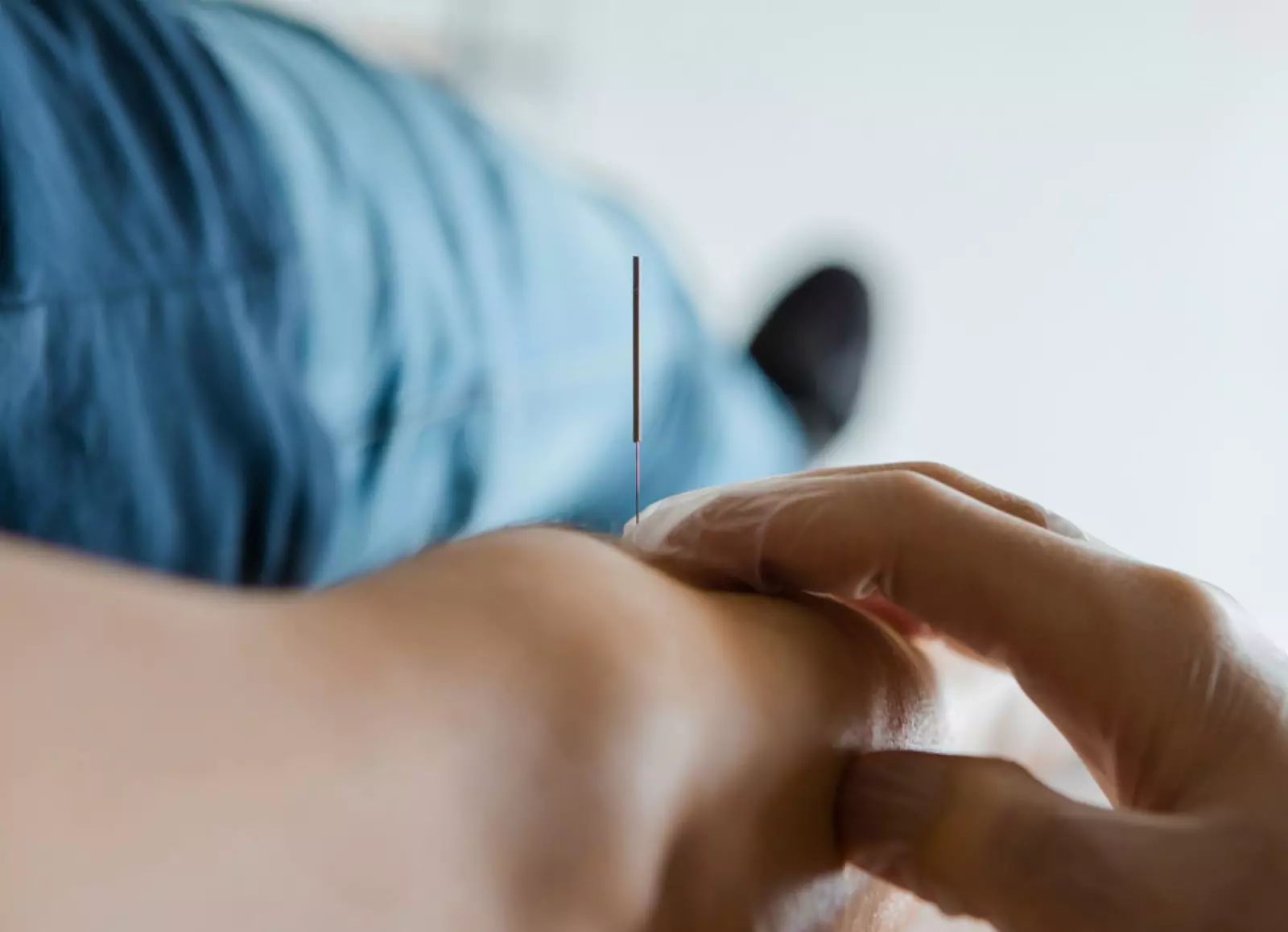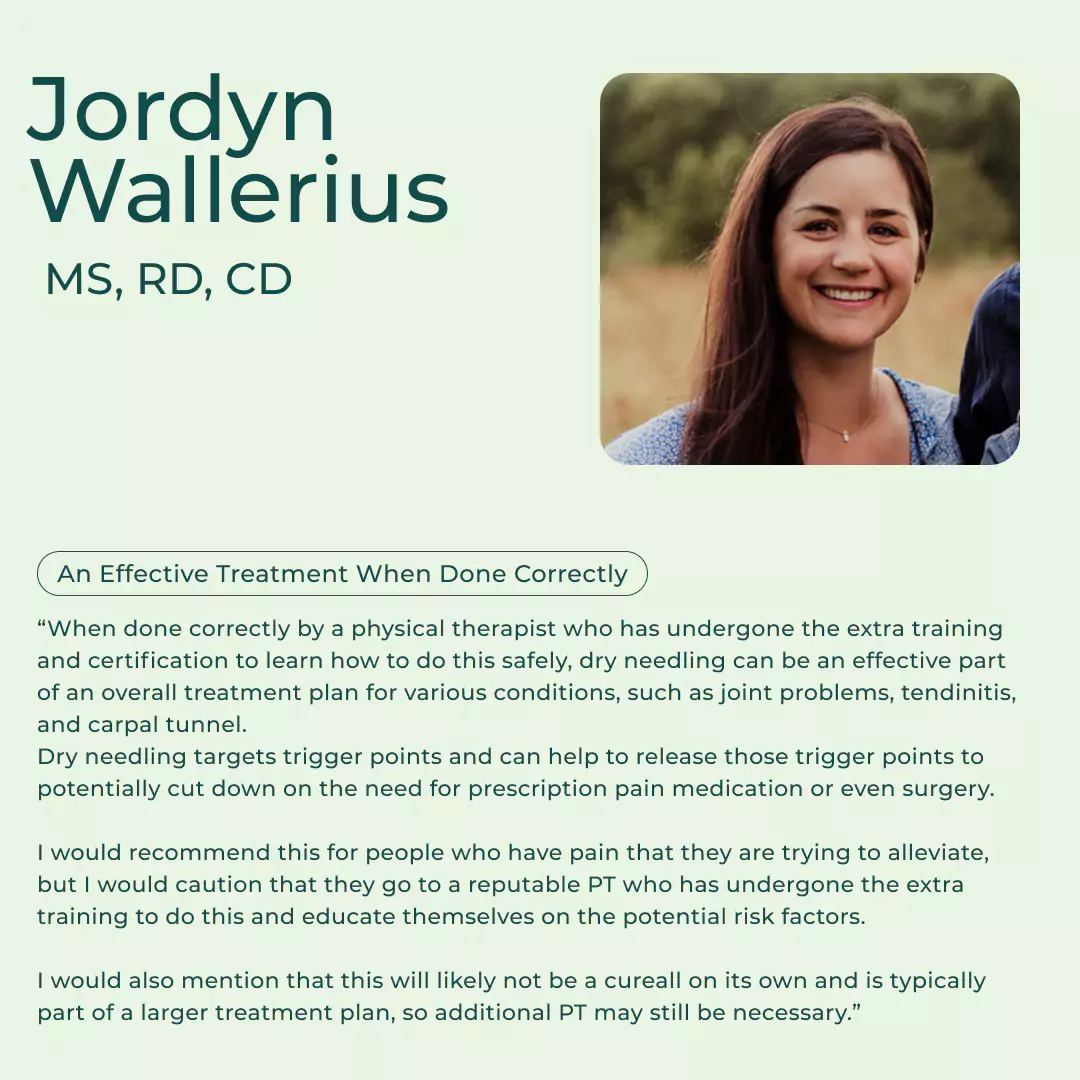Dry Needling: Can it Really Help with Muscle Pain?

Key Takeways
From cryotherapy to acupuncture and Ayurveda to homeopathy, complementary and alternative therapies are growing in popularity. According to Johns Hopkins, 38 percent of American adults use complementary and alternative medicine (CAM).
One such treatment is dry needling or myofascial trigger point dry needling: a relatively new treatment quickly growing in popularity. Although the technique has been around for centuries, practitioners have only recently started using it as a way to treat musculoskeletal pain. The therapy involves inserting thin needles into the skin at specific trigger points.
Historically, dry needling dates back over 2,000 years to ancient China, but this technique has only recently gained widespread popularity worldwide.
It’s believed to be an effective way to treat chronic pain conditions and improve range of motion. But what exactly is dry needling? What muscle groups can it help, and who sets the treatment plan? Is there any scientific proof that it even works? Here’s everything you need to know about dry needling, including what our experts at Nutrisense think of it.
So, What Exactly Is Dry Needling?

As the name suggests, dry needling involves inserting thin needles into specific points in your body's muscles or connective tissues.
While this may sound uncomfortable at first, with the intended benefit of pain relief. When the needles are inserted into a trigger point, they’re said to stimulate the release of biochemical compounds that help relieve pain and reduce tension in the surrounding muscles.
The treatment is intended to help doctors address musculoskeletal problems that may resist conventional medicines and treatments.
As we mentioned, dry needling is the process of stimulating specific pressure points in the body that are associated with pain management and inflammation. When these trigger points are stimulated through the insertion of thin needles, the intended outcome is to send signals to the nervous system that tells your brain to relax and stop producing pain signals from that specific area.
What Are Trigger Points?
The thin needles that your practitioner uses during a dry needling treatment are known as filiform needles. They’re inserted into trigger points, which are specific points on your body that are said to help release muscular tension and stimulate healing.
Why is this thought to be so helpful? Think of it this way: you’ve likely experienced some muscle pain at some point, and it can be very uncomfortable, whether it’s just a cramp or a more serious issue.
In many cases, this muscle pain goes away on its own after a few days. However, some people experience chronic muscle pain that persists for months or even years. The trigger points that the dry needling treatment targets often cause this type of pain.
You can also view trigger points as those knots of muscle that are painful when pressed. They are usually in the upper back, shoulders, and neck. However, they can also occur in other parts of the body, such as your legs and arms.
Trigger points can come up due to repetitive motions, poor posture, and tension. They can also result from an injury or an underlying medical condition.
Not Just a Jab: There’s a Technique to Dry Needling

Remember, much like any other therapy, only skilled, trained physical therapists certified in the procedure should perform dry needling.
There are two main types of needle techniques used in dry needling: in-and-out and rotating methods. Physical therapists and other practitioners commonly use both techniques in an effort to help relieve pain and promote relaxation throughout the body.
Whether you undergo one method or the other depends largely on your individual needs, preferences, and the medical guidance of your practitioner.
1) The In-and-Out Technique
The in-and-out technique involves quickly inserting and retracting the needle multiple times to reach targeted areas of tension and tightness.
2) The Rotating Technique
On the other hand, the rotating method uses a more deliberate movement as the needle is gradually rotated on entry and then during withdrawal from the skin.
You can find out more about the techniques and find a trained physical therapist using a resource like the American Physical Therapy Association (APTA).
What to Expect During a Dry Needling Treatment
Your therapist will create a customized treatment plan based on your specific needs and goals. It may include targeting certain muscles affected by your condition and providing additional techniques like massage or mobilization to promote healing and reduce tension in the surrounding areas.
Your therapist will monitor your muscle tone throughout the session and provide additional support as needed. Additionally, some patients may experience a slight tingling sensation with the insertion of the needles.
Depending on your condition, a dry needling treatment may involve multiple sessions that typically last for about 10 to 15 minutes each. Most patients report feeling minimal pain during the treatment, experiencing only a slight prick or stinging sensation, and only when the practitioner inserts the needles.
Some practitioners also include massage or compression therapy after dry needling to enhance muscle relaxation and further reduce pain levels.
Once they finish the actual needlework, it is normal for clients to experience soreness or minor discomfort at the site of the injections. In most cases, this feeling should subside relatively quickly after the treatment has finished.
If you are ever concerned about how you are feeling after having a dry needling session, speak with your therapist right away so they can address any concerns or issues you might be experiencing.
The Potential Health Benefits of Dry Needling

While research on the specific benefits of dry needling is limited and ongoing, here are a few potential benefits of the therapeutic treatment.
- Dry needling therapy may help to improve circulation in the affected area, possible delivering additional oxygen and nutrients to promote healing.
- Studies have shown that dry needling can help lessen muscle tension that often causes headaches and migraines, making this treatment a valuable tool for relieving debilitating pain.
- Dry needling may help to treat acute injuries like sprains and strains.
- Dry needling may help to improve the pain associated with conditions like joint pain from carpal tunnel syndrome, arthritis, fibromyalgia, and tendonitis.
- Studies have found that incorporating dry needling into regular physical therapy or fitness regimens can be particularly effective for athletes seeking faster recovery from injuries or muscle fatigue.
- Dry needling may relieve the pain experienced after shingles, known as post-herpetic neuralgia.
- Dry needling can help relieve pain from musculoskeletal conditions.
- Doctors sometimes recommend dry needling treatment to relieve low back pain, myofascial pain, neck pain, knee pain, osteoarthritis, plantar fasciitis, sciatica, and other impairments.
What’s the Difference Between Dry Needling and Acupuncture?
Unlike acupuncture, dry needling targets specific areas of the body, and it may help address acute pain in patients who have not had success with other conventional treatments.
Dry needling is typically administered by a physical therapist or other licensed professional and works by releasing localized tension in inflamed muscles and tendons. It may help restore proper blood flow and nerve function to the affected tissue, providing fast relief from chronic pain.
While the tools used to perform dry needling are similar, there are different techniques to employ them from those used by acupuncturists, and its practitioners require different training.
Are There Side Effects to Dry Needling?
There is much debate surrounding the side effects of dry needling. Some healthcare practitioners claim that dry needling has no side effects, while others believe that dry needling can cause some uncomfortable and harmful side effects.
Ultimately, the answer to this question depends on various factors, including the practitioner, the condition being treated, and your reaction to the dry needling treatment.
However, general recommendations suggest those seeking this type of therapy should work closely with their healthcare provider to decide whether dry needling is the right option for their needs.
As with any medical treatment, you should know all the potential risks and drawbacks before undergoing dry needling.
Some common side effects include:
- Muscle soreness or bruising at the needle site.
- Feelings of tightness or tingling in the area.
- A pinching or cramping sensation when needles are placed into muscle tissue.
While the potential side effects of dry needling may seem concerning at first, most are typically mild and disappear shortly after treatment has ended. By understanding these side effects and discussing them with your healthcare provider, you can decide whether this therapy is right for you.
What an Expert Thinks
Is dry needling worth trying? Here’s what one member of our Nutrition Team thinks about this alternative treatment.

Find the right Nutrisense programto turn insight into progress.
Go Beyond Glucose Data with Nutrisense
Your glucose can significantly impact how your body feels and functions. That’s why stable levels are an important factor in supporting overall wellbeing. But viewing glucose isn't enough. Nutrisense, you’ll be able to learn how to use your body's data to make informed lifestyle choices that support healthy living.
One-to-one coaching
Sign up to access insurance-covered video calls to work with a glucose expert: a personal registered dietitian or certified nutritionist who will help tailor your lifestyle and diet to your goals.
Monitor and measure what matters
With the Nutrisense CGM Program, you can monitor your glucose with health tech like glucose biosensors and continuous glucose monitor (CGM)s, and analyze the trends over time with the Nutrisense App. This will help you make the most informed choices about the foods you consume and their impact on your health.
Find your best fit
Ready to take the first step? Start with our quiz to find the right Nutrisense program to help you take control.

Carlee's training at Western Illinois University and an internship at the Memphis VA Hospital lead her to a career in outpatient counseling and bariatric nutrition therapy. In these positions, Carlee realized many of the disease states (upwards of 80%!) her patients experienced were actually preventable. She knew she had to dig deeper into preventative health and has since been passionate about helping people translate this complex glucose data into actionable changes anyone can implement into their everyday lives.




